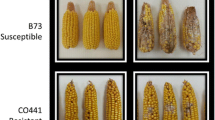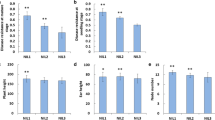Abstract
Ear rot, caused by Fusarium verticillioides (FV), is a destructive disease of maize as it reduces grain yield and increases risks of mycotoxin production, thus endangering livestock. To identify genes differentially expressed during FV infection, four cDNA libraries were constructed for suppression subtractive hybridization using RNA isolated from bracts of an FV-resistant inbred maize line, Bt-1, as well as an FV-susceptible maize inbred line, Ye478. A total of 145 clones were obtained following reverse dot-blot hybridization, and these were sequenced from these libraries. Similarity analysis revealed that of these genes, 93 were unique, including 68 of known function, 24 of unknown function, and a single novel gene. Most genes of known function were predominantly involved in plant defense such as cell defense, transcription regulation, signal transduction, and metabolism. Expression profiles of eight representative genes, using semiquantitative reverse transcription-polymerase chain reaction, confirmed that differential gene regulation during FV infection was involved. These findings suggested that these differentially expressed genes might be involved in FV defense responses in maize.




Similar content being viewed by others
References
Ali ML, Taylor JH, Jie L, Sun G, William M, Kasha KJ, Reid LM, Pauls KP (2005) Molecular mapping of QTLs for resistance to Gibberella ear rot, in corn, caused by Fusarium graminearum. Genome 48:521–533
Bradford MM (1976) A rapid and sensitive method for the quantitation of microgram quantities of protein utilizing the principle of protein-dye binding. Anal Biochem 72:248–254
Capelli N, Diogon T, Greppin H, Simon P (1997) Isolation and characterization of a cDNA clone encoding an osmotin-like protein from Arabidopsis thaliana. Gene 191:51–56
Casacuberta JM, Puigdomenech P, San Segundo B (1991) A gene coding for a basic pathogenesis-related (PR-like) protein from Zea mays. Molecular cloning and induction by a fungus (Fusarium moniliforme) in germinating maize seeds. Plant Mol Biol 16:527–536
Casacuberta JM, Raventos D, Puigdomenech P, San Segundo B (1992) Expression of the gene encoding the PR-like protein PRms in germinating maize embryos. Mol Gen Genet 234:97–104
Chen W, Wu JY, Yuan HX (2002) Identification of resistance on maize germplasm to maize ear rot. J Maize Sci 10(59–60):101
Chen N, Yang QL, Su MW, Pan LJ, Chi Y, Chen MN, He YN, Yang Z, Wang T, Wang M, Yu SL (2012) Cloning of six ERF family transcription factor genes from peanut and analysis of their expression during abiotic stress. Plant Mol Biol Rep 30(6):1415–1425. doi:10.1007/s11105-012-0456-0
Chungu C, Mather DE, Reid LM, Hamilton RI (1996) Inheritance of kernel resistance to Fusarium graminearum in maize. J Hered 87:382–385
Cordero MJ, Raventos D, San Segundo B (1992) Induction of PR proteins in germinating maize seeds infected with the fungus Fusarium moniliforme. Physiol Mol Plant Pathol 41:189–200
Cordero MJ, Raventos D, San Segundo B (1994a) Expression of a maize proteinase inhibitor gene is induced in response to wounding and fungal infection: systemic wound response of a monocot gene. Plant J 6:141–150
Cordero MJ, Raventos D, San Segundo B (1994b) Differential expression and induction of chitinases and β-1, 3-glucanases in response to fungal infection during germination of 14 maize seeds. Mol Plant Microbe Interact 7:23–31
Delledonne M, Zeier J, Marocco A, Lamb C (2001) Signal interactions between nitric oxide and reactive oxygen intermediates in the plant hypersensitive disease resistance response. Proc Natl Acad Sci 98:13454–13459
Diatchenko L, Lukyanov S, Lau YFC, Chenchik A, Moqadam F, Huang B, Lukyanov S, Lukyanov K, Gurskaya N, Sverdlov ED, Siebert PD (1999) Suppression subtractive hybridization: a versatile method for identifying differentially expressed genes. Methods Enzymol 303:349–380
Ding JQ, Wang XM, Chander S, Yan JB, Li JS (2008) QTL mapping of resistance to Fusarium ear rot using a RIL population in maize. Mol Breeding 22:395–403
Dong X (1998) SA, JA, ethylene, and disease resistance in plants. Curr Opin Plant Biol 1:316–323
Edelmann MJ, Kessler BM (2008) Ubiquitin and ubiquitin-like specific proteases targeted by infectious pathogens: emerging patterns and molecular principles. Biochim Biophys Acta 1782:809–816
Edreva A (2005) Pathogenesis-related proteins: research progress in the last 15 years. Gen Appl Plant Physiol 31:105–124
Eulgem T (2005) Regulation of the Arabidopsis defense transcriptome. Trends Plant Sci 10:71–78
Fraire-Velazquez S, Lozoya-Gloria E (2003) Differential early gene expression in Phaseolus vulgaris to Mexican isolates of Colletotrichum lindemuthianum in incompatible and compatible interactions. Physiol Mol Plant Pathol 63:79–89
Fung RWM, Gonzalo M, Fekete C, Kovacs LG, He Y, Marsh E, McIntyre LM, Schachtman DP, Qiu WP (2008) Powdery mildew induces defense-oriented reprogramming of the transcriptome in a susceptible but not in a resistant grapevine. Plant Physiol 146:236–249
Glazebrook J (2005) Contrasting mechanisms of defense against biotrophic and necrotrophic pathogens. Annu Rev Phytopathol 43:205–227
Greenberg JT (1997) Programmed cell death in plant–pathogen interactions. Annu Rev Plant Physiol Plant Mol Biol 48:525–545
Han Y, Wang Y, Bi JL, Yang XQ, Huang Y, Zhao X, Hu Y, Cai QN (2009) Constitutive and induced activities of defense-related enzymes in aphid-resistant and aphid-susceptible inbred lines of wheat. J Chem Ecol 35:176–182
Heath MC (2000) Hypersensitive response-related death. Plant Mol Biol 44:321–334
Husaini AM, Rafiqi AM (2011) Role of osmotin in strawberry improvement. Plant Mol Biol Rep 30:1055–1064. doi:10.1007/s11105-011-0394-2
Jiang TB, Fountain J, Davis G, Kemerait R, Scully B, Lee RD, Guo BZ (2012) Root morphology and gene expression analysis in response to drought stress in maize (Zea mays). Plant Mol Biol Rep 30:360–369
Jin H, Martin C (1999) Multifunctionality and diversity within the plant MYB-gene family. Plant Mol Biol 41:577–585
Johal GS, Briggs SP (1992) Reductase activity encoded by the HM1 disease resistance gene in maize. Science 258:985–987
Kim BG, Fukumoto T, Tatano S, Gomi K, Ohtani K, Tada Y, Akimitsu K (2009) Molecular cloning and characterization of a thaumatin-like protein-encoding cDNA from rough lemon. Physiol Mol Plant Pathol 7:1–8
Kinkema M, Fan W, Dong X (2000) Nuclear localization of NPR1 is required for activation of PR gene expression. Plant Cell 12:2339–2350
Lebel E, Heifetz P, Thorne L, Uknes S, Ryals J, Ward E (1998) Functional analysis of regulatory sequences controlling PR-1 gene expression in Arabidopsis. Plant J 16:223–233
Li YL, Long SS, Guo JZ, Zhang YH, Li Q, Wang W (2003) Changes of activities of PAL and POD and bands of POD isozyme of susceptible and resistant corn infected with Fusarium graminearum. Acta Bot Boreal Occident Sin 23:1927–1931
Li DM, Staehelin C, Zhang YS, Peng SL (2009) Identification of genes differentially expressed in Mikania micrantha during Cuscuta campestris infection by suppression subtractive hybridization. J Plant Physiol 166:1423–1435
Li ZM, Ding JQ, Wang RX, Chen JF, Sun XD, Chen W, Song WB, Dong HF, Dai XD, Xia ZL, Wu JY (2011) A new QTL for resistance to Fusarium ear rot in maize. J Appl Genet 52:403–406
Liang Q, Hou MS (2004) The relation between the MRDV resistance and the peroxidase of maize varieties. J Yunnan Agric Univ 19(5):546–549
Mauch-Mani B, Mauch F (2005) The role of abscisic acid in plant–pathogen interactions. Curr Opin Plant Biol 8:409–414
Multani DS, Meeley RB, Paterson AH, Gay J, Briggs SP, Johal GS (1998) Plant–pathogen microevolution: molecular basis for the origin of a fungal disease in maize. Proc Natl Acad Sci 95:1686–1691
Munkvold GP (2003) Epidemiology of Fusarium diseases and their mycotoxins in maize ears. Eur J Plant Pathol 109:705–771
Murillo I, Jaeck E, Cordero MJ, San Segundo B (2001) Transcriptional activation of a maize calcium-dependent protein kinase gene in response to fungal elicitors and infection. Plant Mol Biol 45:145–158
Pieterse CMJ, Van Loon LC (1999) Salicylic acid-independent plant defence pathways. Trends Plant Sci 4:52–58
Reid LM, Nicol RW, Ouellet T, Savard M, Miller JD, Young JC, Stewart DW, Schaafsma AW (1999) Interaction of Fusarium graminearum and F. moniliforme in maize ears: disease progress, fungal biomass, and mycotoxin accumulation. Phytopathology 89:1028–1037
Robertson-Hoyt LA, Jines MP, Balint-Kurti PJ, Kleinschmidt CE, White DG, Payne GA, Maragos CM, Molnar TL, Holland JB (2006) QTL mapping for Fusarium ear rot and fumonisin contamination resistance in two maize populations. Crop Sci 46:1734–1743
Sano H, Ohashis Y (1995) Involvement of small GTP-binding proteins in defense signal-transduction pathways of higher plants. Proc Natl Acad Sci 92:4138–4144
Sano H, Seo S, Orudgev E, Youssefian S, Ishizuka K, Ohashi Y (1994) Expression of the gene for a small GTP binding protein in transgenic tobacco elevates endogenous cytokinin levels, abnormally induces salicylic acid in response to wounding, and increases resistance to tobacco mosaic virus infection. Proc Natl Acad Sci 91:10556–10560
Schenk PM, Kazan K, Manners JM, Anderson JP, Simpson RS, Wilson IW, Anderson JP, Somerville SC, Maclean DJ (2000) Coordinated plant defense responses in Arabidopsis revealed by microarray analysis. Proc Natl Acad Sci 97:11655–11660
Sekhon RS, Kuldau G, Mansfield M, Chopra S (2006) Characterization of Fusarium-induced expression of flavonoids and PR genes in maize. Physiol Mol Plant Pathol 69:109–117
Singh KB, Foley RC, Oñate-Sánchez L (2002) Transcription factors in plant defense and stress responses. Curr Opin Plant Biol 5:430–436
Tao Y, Xie ZY, Chen WQ, Glazebrook J, Chang HS, Han B, Zhu T, Zou GZ, Katagiri F (2003) Quantitative nature of Arabidopsis responses during compatible and incompatible interactions with the bacterial pathogen Pseudomonas syringe. Plant Cell 15:317–330
Thompson CE, Fernandes CL, de Souza ON, Salzano FM, Bonatto SL, Freitas LB (2006) Molecular modeling of pathogenesis-related proteins of family 5. Cell Biochem Biophys 44:385–394
Van Loon LC, Gerritsen YAM (1989) Protease activity and pathogenesis-related proteins in virus infected Samsun NN tobacco leaves. Plant Sci 63:141–150
Vigier B, Reid LM, Dwyer LM, Stewart DW, Sinha RC, Arnason JT, Butler G (2001) Maize resistance to Gibberella ear rot: symptoms, deoxynivalenol, and yield. Can J Plant Pathol 23:99–105
Weidenborner M (2001) Foods and fumonisins. Eur Food Res Technol 212:262–273
Wen CJ, Chen XJ, Chen WR (2002) Fusarium ear rot of corn and methods used in resistance test. J Sichuan Agric Univ 20:321–323
Yang Y, Klessig DF (1996) Isolation and characterization of a tobacco mosaic virus-inducible myb oncogene homolog from tobacco. Proc Natl Acad Sci 93:14972–14977
Young ND (1996) QTL mapping and quantitative disease resistance in plants. Annu Rev Phytopathol 34:479–501
Yuan J, Ali ML, Taylor J, Liu J, Sun G, Liu W, Masilimany P, Gulati-Sakhuja A, Pauls KP (2008) A guanylyl cyclase-like gene is associated with Gibberella ear rot resistance in maize (Zea mays L.). Theor Appl Genet 116:465–479
Yuan GS, Zhang ZM, Xiang K, Zhao MJ, Shen YO, Pan GT (2012) Large-scale identification of differentially expressed genes in maize inbreds susceptible and resistant to Fusarium ear rot. Plant Omics J 5:471–475
Yun DJ, Ibeas JI, Lee H, Coca MA, Narasimhan ML, Uesono Y, Hasegawa PM, Pardo JM, Bressan RA (1998) Osmotin, a plant antifungal protein, subverts signal transduction to enhance fungal cell susceptibility. Mol Cell 1:807–817
Zhang F, Wan XQ, Pan GT (2006) QTL mapping of Fusarium moniliforme ear rot resistance in maize. 1. Map construction with microsatellite and AFLP markers. J Appl Genet 47:9–15
Zhang Y, Feng DS, Bao YG, Ma X, Yin N, Xu JQ, Wang HG (2012) A novel wheat related-to-ubiquitin gene TaRUB1 is responsive to pathogen attack as well as to both osmotic and salt stress. Plant Mol Biol Rep 31(1):151–159. doi:10.1007/s11105-012-0476-9
Zheng J, Fu J, Gou M, Huai J, Liu Y, Jian M, Huang Q, Guo X, Dong Z, Wang H, Wang G (2010) Genome-wide transcriptome analysis of two maize inbred lines under drought stress. Plant Mol Biol 72:407–421
Acknowledgments
We thank Dr. Yunbi Xu and Dr. Xiaoyang Zhu for their comments on this manuscript. This project was financially supported by grants from the Natural National Science Foundation of China (nos. 30571173 and 31201274), Program for Changjiang Scholars and Innovative Research Team in University of China (grant no. IRT0453), and National High Technology Research and Development Program of China (863 Program) (no. 2012AA10A307).
Author information
Authors and Affiliations
Corresponding author
Rights and permissions
About this article
Cite this article
Yuan, G., Zhang, Z., Xiang, K. et al. Different Gene Expressions of Resistant and Susceptible Maize Inbreds in Response to Fusarium verticillioides Infection. Plant Mol Biol Rep 31, 925–935 (2013). https://doi.org/10.1007/s11105-013-0567-2
Published:
Issue Date:
DOI: https://doi.org/10.1007/s11105-013-0567-2




